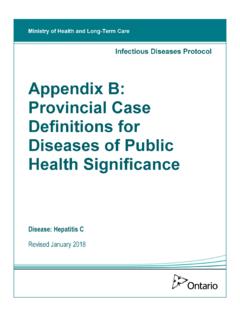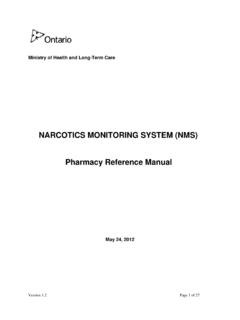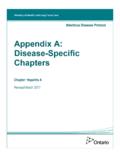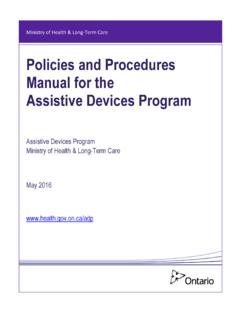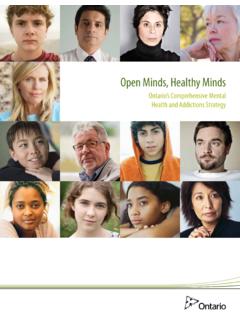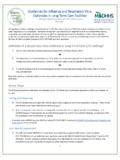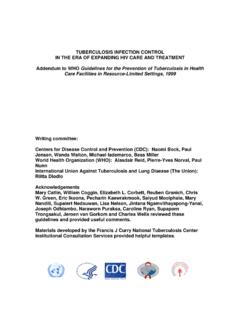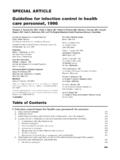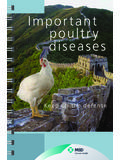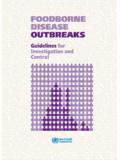Transcription of Appendix B: Provincial Case Definitions for Diseases of ...
1 Ministry of Health and Long-Term Care Infectious Diseases Protocol Appendix B: Provincial case Definitions for Diseases of Public Health Significance Disease: Respiratory I nfection Outbreaks in Institutions and Public Hospitals Effective: May 2018 Health and Long-Term Care 2 Disease Provincial Reporting Confirmed outbreaks Type of Surveillance outbreak summary data case Classification Confirmed outbreak definition * Confirmed respiratory infection outbreak : Two cases of acute respiratory infections (ARI) within 48 hours with any common epidemiological link ( , unit, floor), at least one of which must be laboratory-confirmed; OR Three cases of ARI (laboratory confirmation not necessary) occurring within 48 hours with any common epidemiological link ( , unit, floor); Suspect outbreak definition * Suspect respiratory infection outbreak : Two cases of ARI occurring within 48 hours with any common epidemiological link ( , unit, floor).
2 OR One laboratory-confirmed case of influenza * definition caveats for public hospitals: Cases refer to health care-associated cases If rapid testing is conducted on all cases, the confirmed outbreak definition would apply if two cases have the same respiratory pathogen Laboratory Evidence Laboratory Confirmation Laboratory confirmation is not required to be classified as a confirmed institutional or public hospital respiratory infection outbreak . Health and Long-Term Care 3 Approved/Validated Tests Standard or rapid (shell vial) culture for respiratory viruses; Direct fluorescent antibody (DFA) antigen testing for respiratory viruses; Nucleic acid amplification test (NAAT) for respiratory viruses; and Rapid enzyme immunoassay (EIA) or immunochromatographic test (ICT) kits for respiratory viruses, such as influenza virus and respiratory syncytial virus (RSV).
3 Indications and Limitations PHO will send one isolate from each influenza outbreak to the National Microbiology Laboratory to be typed for strain identification. I f further laboratory support is required please contact Public Health Ontario Laboratories. Clinical Evidence Clinically compatible signs and symptoms in individuals who are part of an outbreak include, but are not limited to, the following: Upper respiratory tract illness ( , common cold, pharyngitis); Runny nose or sneezing; Stuffy nose ( , congestion); Sore throat or hoarseness or difficulty swallowing; Dry cough; Swollen or tender glands in the neck ( , cervical lymphadenopathy); Fever/abnormal temperature for the resident/patient may be present, but is not required; Tiredness ( , malaise); Muscle aches ( , myalgia).
4 Loss of appetite; Headache; and Chills. ICD Code(s) ICD 10 Code J22a Comments Different respiratory viruses often cause similar acute respiratory symptoms. Each respiratory infection outbreak requires its own case definition . The case definition should be developed for each individual outbreak based on its characteristics, reviewed during the course of the outbreak , and modified if necessary, to ensure that the majority of cases are captured by the definition . For more information, please consult Investigation and Management of Infectious Health and Long-Term Care 4 Diseases Outbreaks in the Infectious Disease Protocol, 2018 (or as current) and the Ins titution/Facility outbreak Management Protocol, 2018 (or as current).
5 An epidemiological link can refer to, but is not limited to, common unit/floor, common staff, shared activities or dining area, common visitors etc. An Acute Respiratory Infection (ARI) is any new onset acute respiratory infection (either upper or lower respiratory tract), which presents with symptoms of a new or worsening cough or shortness of breath and often fever (also known as febrile respiratory illness, or FRI). It should be noted that elderly people and people who are immunocompromised may not have a febrile response to a respiratory infection. Health care-associated refers to an infection that is acquired during the delivery of health care that was not present or incubating at the time of admission.
6 It also includes such infections among staff. (Also known as nosocomial infection). Declaration of an outbreak can be made by either the institution/health facility or the medical officer of health (MOH). In the event of a disagreement between the institution and the MOH, the MOH has the authority to determine if an outbreak of a communicable disease exists, for purposes of exercising statutory powers under the Health Protection and Promotion Act. Once an outbreak is declared, it is reported to the Ministry of Health and Long-Term Care (ministry) through the integrated Public Health Information System (iPHIS).
7 The board of health shall declare whether an outbreak is over, in consultation with the institution/facility. Rationale for declaring or not declaring an outbreak , and declaring an outbreak over should be documented. Issuing a media release to the public is the responsibility of the institution or health facility. Should there be a public health risk to the general population, a joint media alert may be issued, or the public health unit may issue an alert on behalf of the institution or health facility with their knowledge. Sources Ontario, Ministry of Health and Long-Term Care.
8 A Guide to the Control of Respiratory Infection Outbreaks in Long-Term Care Homes. Toronto, ON: Queen's Printer for Ontario; 2016. Available from: Ontario Agency for Health Protection and Promotion (Public Health Ontario), Provincial Infectious Diseases Advisory Committee. Annex B: Best Practices for Prevention of Transmission of Acute Respiratory Infection. Annexed to: Routine Practices and Additional Precautions in All Health Care Settings. Toronto, ON: Queen s Printer for Ontario; 2013. Available from: http: Agency for Health Protection and Promotion (Public Health Ontario).
9 IPHIS User Guide: Respiratory Infection Outbreaks in Institutions. User Guide v. Toronto, ON: Queen's Printer for Ontario; 2014. Health and Long-Term Care 5 Document History Table 1: History of Revisions Revision Date Document Section Description of Revisions April 2015 General New template. Throughout the document, acute respiratory tract illness replaced with acute respiratory infections (ARI) . Section Document History added April 2015 Approved / Validated Tests Entire section revised. April 2015 Indications Section title revised from Indications and Limitations to Indications.
10 Entire section revised. April 2015 Clinical Evidence Clinically compatible signs and symptoms include but are not limited to the following: changed to Clinically compatible signs and symptoms in individuals who are part of an outbreak include, but are not limited to, the following: April 2015 Sources Revised section title. All sources updated. April 2018 General Updates reflect changes to the Disease of Public Health Significance list and the addition of public hospitals.

